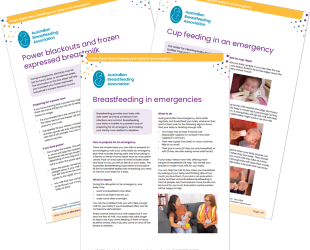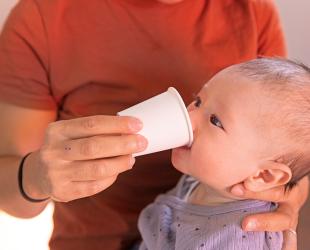A little planning will help to protect your baby or young child in a disaster.
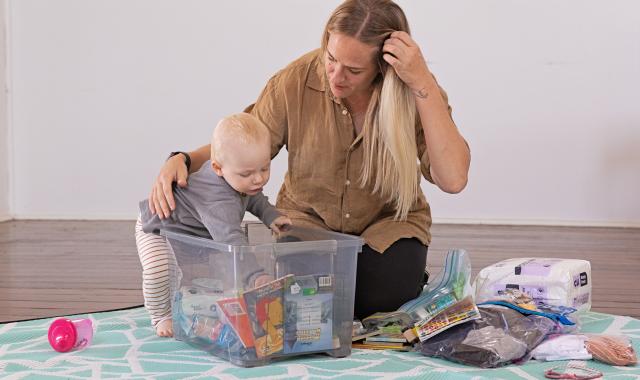
Disasters and emergencies happen often across Australia. Having an emergency plan and an evacuation kit packed will help to protect your baby or young child if your family is impacted.
Adults and older children can survive with only water (or other drink) for several days. But babies and toddlers can quickly become very ill if they don’t have the right food. This is why it’s important to know what you’ll need to care for your baby in an emergency.
Six steps every family can take
Planning ahead is one of the most important things you can do to protect your young family. These simple steps will help you to make your own emergency plan:
- Plan to leave early.
- Pack an evacuation kit with all the items needed to care for your child for 3 days.
- Arrange to evacuate to a friend or family member’s home, rather than an evacuation centre, if possible.
- Decide how you will get there.
- Know who you will contact to tell them you are leaving and that you have arrived safely.
- Have a back-up plan.
Why pack an evacuation kit?
In an emergency, there may be little or no time for you to gather the items needed to care for your baby. Even if you have warning, it can be difficult to think clearly. Packing at the last minute can slow you down and put your family at risk. To be prepared, pack an evacuation kit ahead of time and update it often.
Your kit should include all the items needed to care for your child for 3 days without access to mains water and electricity. As well as feeding supplies, storing enough nappies, wipes and other essential items can make coping with an emergency easier. These supplies can be stored together in a lidded plastic box. The inside of the lid can act as a clean area to prepare any expressed breastmilk, formula or family foods your child may be having.
Read on to learn more about preparing for emergencies depending on your child’s age and how they are fed.
The value of breastfeeding in emergencies
Breastmilk provides babies with safe food and water. It also helps to protect against infections that are common in emergency situations. Continuing to breastfeed your baby through the emergency season is one way to be prepared.
When your baby is breastfed, they have a steady supply of safe drink and food as long as you are together. This can provide you with much needed peace of mind in an emergency or disaster.
Breastfeeding is also a source of comfort for young children during times of stress. The familiar comfort of a breastfeed can help to protect your child from the stress and disruption of a disaster.
How you prepare depends on how your baby is fed
If your baby is only having your breastmilk, and only at the breast, you don’t need to store any supplies for feeding your baby in an emergency, except some water for you and breast pads if you use them.
Even in extreme hot weather, breastmilk provides all the fluid your baby needs. Your baby doesn't need extra water. Giving water to a young baby can be harmful. It can cause severe health problems, like water intoxication, because their kidneys are not fully developed.
Emergencies can be very stressful. Despite what you may have heard, stress will not stop you making milk. However, it can slow the let-down reflex. Your baby may seem fussy at the breast and take longer to feed. Encourage your baby to keep sucking until your milk flows. There are also other simple ways to help your milk to flow.
Call a breastfeeding counsellor if you need some reassurance about your milk supply. They can provide you with information and support to help you manage breastfeeding through the emergency.
Find out more about caring for your breastfed baby in an emergency:
Many mums across Australia sometimes or always express breastmilk for their baby using an electric breast pump. However, during an emergency you may have no electricity or mains water. Without hot water, you can't even clean a hand pump or feeding bottles properly.
If you learn to hand express, your baby can continue to receive your breastmilk in an emergency. You can feed this breastmilk to your baby using a cup. A breastfeeding counsellor can help to talk you through this.
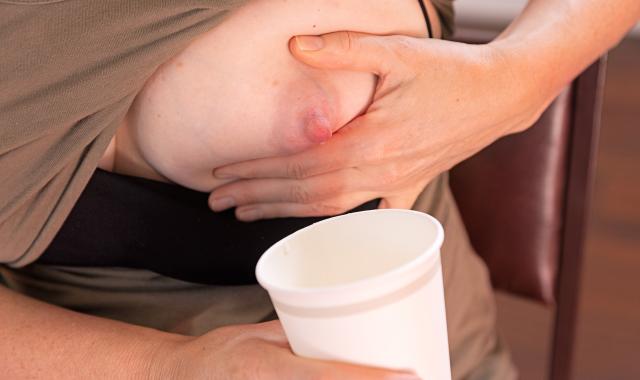
Find out more about expressing and using breastmilk in an emergency:
Formula feeds can be more difficult in an emergency, especially if there is no electricity or clean water. If you are mixed feeding (your baby is having some breastfeeds and some formula) you may like to think about whether you could return to only breastfeeding them. More frequent feeds at the breast will increase the amount of breastmilk you make. Chat to a breastfeeding counsellor for more practical tips to help you increase your supply so you can reduce or stop your baby’s formula feeds.
If your baby is fully formula-fed, pack your emergency kit as though you will be without power or water. Unless you have unlimited access to hot water, you won't be able to wash feeding bottles well enough for them to be safe. For this reason, your emergency kit should include single-use feeding equipment (one bottle and teat or disposable cup for each feed). All bottles should be sterilised and dried completely before being sealed individually in ziplock bags.
You will also need to store formula and bottled water in case shops are closed or supplies to your area are disrupted.
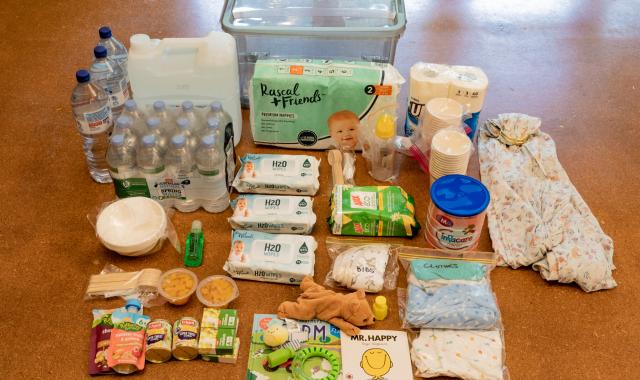
Find out more about formula feeding in an emergency:
If your child is over 6 months and has begun to eat family foods, you may wish to pack some suitable solid foods in your evacuation kit. However, older babies and toddlers can return to having only milk feeds if solid food is not available in an emergency. Disposable bowls and cutlery can be helpful for mealtimes and water can be offered in a cup.
Some small toys and activities can stop older babies and toddlers from becoming restless during the disruption of an emergency. Learn what else to pack with our range of downloadable evacuation kit lists for every age and feeding type.
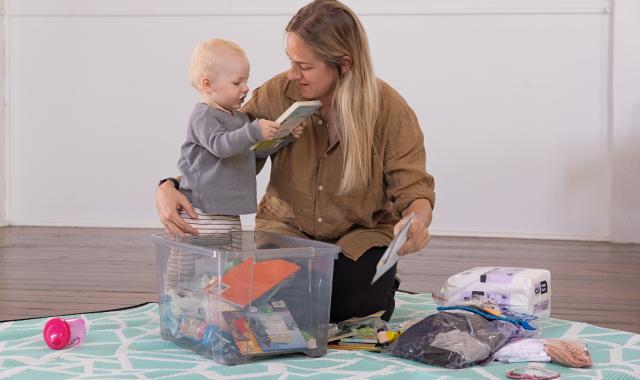
Getting help
Those who are around mums, babies and young families in an emergency can be a source of great support. But often they don’t know how best to help. Let them know how they can lighten your load so you can focus on the needs of your baby or toddler. Perhaps they could queue for supplies for you, help with older children, or find a private space for you to breastfeed your baby or rest.
ABA volunteers are able to offer information and support in emergencies, no matter how your child is fed. To speak to a breastfeeding counsellor, call the Breastfeeding Helpline at any time on 1800 686 268.
More about emergency preparedness
Further information for parents on preparing for emergencies is available from the Australian Red Cross and various state and territory emergency services. Some include specific information about feeding babies.
- Australia-wide - Australian Red Cross Emergency preparedness guide
- Australian Capital Territory - Be Emergency Ready
- New South Wales – Get Ready NSW
- Northern Territory - Secure NT
- Queensland - Food during a disaster
- South Australia - Emergencies and safety
- Tasmania - State Emergency Service Plan and Prepare
- Victoria - Evacuating with infants in an emergency
- Western Australia - Hazard Information
© Australian Breastfeeding Association June 2024
Australian Breastfeeding Association and Western Sydney University. (2023). 'Want to help the children? Help the parents': Challenges and solutions from the Babies and Young Children in the Black Summer (BiBS) Study. DOI: 10.26183/ggeh-p937
Gribble, K. & Berry, N. (2011). Emergency preparedness for those who care for infants in developed country contexts. International Breastfeeding Journal 16(6):1–12.
Gribble, K., Peterson, M., & Brown, D. (2019). Emergency preparedness for infant and young child feeding in emergencies (IYCF-E): An Australian audit of emergency plans and guidance. BMC Public Health, 19(1),1278.
Williams, H. G. (2006). ‘And not a drop to drink': Why water is harmful for newborns. Breastfeeding Review 14(2):5–9.
